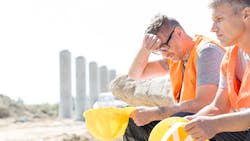Safety 2016: Proper Training, Clothing Key to Heat, Cold Stress Prevention
The old United States Postal Service adage says that postal carriers will deliver mail “Neither snow nor rain nor heat nor gloom of night.”
Although this unofficial creed is most associated with the USPS, it also applies to those in many other industries who face harsh environmental conditions every day.
Donald Garvey, construction technical specialist at 3M, spoke about the importance of protecting workers against heat and cold stress at Safety 2016.
Heat Stress
Drawing on his experience both in the field and as a tri-athlete and marathoner, Garvey reinforced the crucial issue of keeping workers hydrated and cool to avoid symptoms such as heat rash, cramps and exhaustion.
While these certain heat stress symptoms are not life-threatening, they do contribute to a significant increase in safety hazards due to a number of factors including:
- Loss of productivity
- Irritability
- Fatigue
- Low morale
- Absenteeism
- Short-cuts in procedure
At certain temperatures, air movement might actually work counterproductive to keeping workers cool as they sweat. Evaporation is critical to the body’s cooling process. For example, an 85 °F day with 90 percent relative humidity is going to be more stressful to a worker than a 100 °F day at 10 percent relative humidity.
“The effectiveness of sweating is something we need to be conscious of,” Garvey said.
Another factor to be cognizant of are physiological factors such as weight loss that could indicate dehydration. A worker could lose up to 2 percent of their body weight before they need to drink water, which is why advocating for small drinks on a regular basis is so critical to keeping workers hydrated.
Garvey also pointed out an available Urine Color Test chart published on the ’s website. While an employee cannot weigh themselves during the day, being mindful of urine color could signal the employee that they need to drink more.
“There’s always that one guy that wants to show he can lift more, push more, move more – he may even push harder,” Garvey said. “You cannot toughen yourself up to dehydration.”
Most of the time a typical American diet will accommodate for salt lost through sweat, he said. However, in a profuse sweating situation, electrolytes do come into play, in which case popular sports drinks might be appropriate.
The key to reduce heat stress in the workplace, however, begins with education and advocating proper cooling and hydration methods from the top down.
“Supervisors need to make a concerted effort to get workers to drink water and make sure workers understand timed drinking, not just thirst drinking,” he said.
In addition, workers could be on a buddy system to keep watch on each other’s condition and watch for warning signs of heat stress. Worker rotation, identifying proper rest cycles, pre-planned actions when a high heat day is predicted, scheduling hot or physically demanding jobs for the cool part of the day is also important.
“When we start skipping procedures these somewhat small heat issues become a safety hazard,” Garvey said.
Cold Stress
While not as dangerous or common as heat stress, cold stress on the job is still something for which supervisors and workers need to be educated and trained, Garvey said.
“The fact of the matter is, no one talks about cold stress,” he said.
Just like heat stress, there is an acclimation period of about ten days and most cold-related injuries occur within that time. Early warning signs include shivering, fatigue and even dehydration. Garvey once again advocated for regular, timed drinks since a worker is not able to distinguish how thirsty they really are in extreme conditions.
Frostbite is a common condition that occurs in weather lower than 32°F. Inadequate clothing, inactivity and direct contact with cold metal are all factors contributing to frostbite that can be avoided, he said.
More serious conditions are first signaled with severe shivering and pain in the extremities. These are danger signs, and a worker experiencing these should be removed immediately from the conditions, Garvey said.
If a worker stops shivering and has bluish skin, immediate medical attention must be sought before hypothermia sets in. As body temperature drops, blood moves internally to protect vital organs. So, warming the center of the body first is crucial so those organs are protected, Garvey said.
Likewise, if a worker is conscious, warm beverages are appropriate. However, if no pulse is detected, CPR must immediately begin and continue until emergency medical services arrive, he said.
Garvey emphasized the importance of proper clothing including wearing waterproof, insulated, loose fitting boots and clean socks.
“Keeping your feet clean and dry is important,” Garvey said. “Oils and dirt affect insulation ability.”
In addition, multiple layers are imperative. Each layer should have a different function for the most effectiveness. The inner most layer should be wicking to absorb any excess body moisture. The middle layer should offer insulation, and the outer layer should protect from weather conditions, he said.
Balancing high and low intensity work will also lower the risk of cold stress.
“You don’t want the worker to get worked up and sweaty in cold conditions,” Garvey said.
Training for cold stress should begin around October before the cold weather hits. Just like heat stress, making sure workers recognize the warning signs is critical. Lastly, having a buddy system to recognize warning signs should also be implemented, he said.
